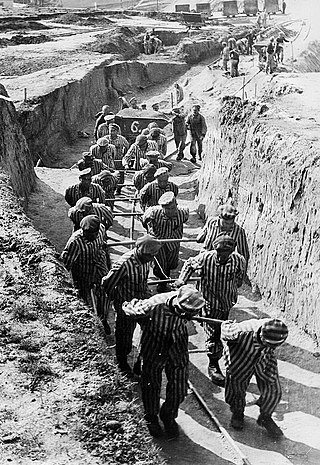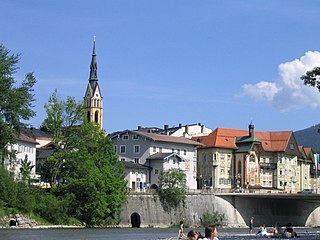
Mauthausen was a Nazi concentration camp on a hill above the market town of Mauthausen, Upper Austria. It was the main camp of a group with nearly 100 further subcamps located throughout Austria and southern Germany. The three Gusen concentration camps in and around the village of St Georgen/Gusen, just a few kilometres from Mauthausen, held a significant proportion of prisoners within the camp complex, at times exceeding the number of prisoners at the Mauthausen main camp.

Aufseherin was the position title for a female guard in Nazi concentration camps. Of the 50,000 guards who served in the concentration camps, training records indicate that approximately 3,500 were women. In 1942, the first female guards arrived at Auschwitz and Majdanek from Ravensbrück. The year after, the Nazis began conscripting women because of a shortage of male guards. In the context of these camps, the German position title of Aufseherin translates to (female) "overseer" or "attendant". Later female guards were dispersed to Bolzano (1944–1945), Kaiserwald-Riga (1943–44), Mauthausen, Stutthof (1942–1945), Vaivara (1943–1944), Vught (1943–1944), and at Nazi concentration camps, subcamps, work camps, detention camps and other posts.

From 1933 to 1945, Nazi Germany operated more than a thousand concentration camps, including subcamps on its own territory and in parts of German-occupied Europe.

German Earth and Stone Works was an SS-owned company created to procure and manufacture building materials for state construction projects in Nazi Germany. DEST was a subsidiary company of Amtsgruppe W of SS Main Economic and Administrative Office (WVHA). Both Amt. W and the WVHA were headed by Waffen-SS generals Oswald Pohl and Georg Lörner.

Bad Tölz is a town in Bavaria, Germany and the administrative center of the Bad Tölz-Wolfratshausen district.

Martin Gottfried Weiss, alternatively spelled Weiß, was the commandant of the Dachau concentration camp in 1945 at the time of his arrest. He also served from April 1940 until September 1942 as the commandant of Neuengamme concentration camp, and later, from November 1943 until May 1944, as the fourth commandant of Majdanek concentration camp. He was executed for war crimes.

Bruck an der Großglocknerstraße is a municipality in Zell am See District, in the state of Salzburg in Austria.
The München-Schwabing labor camp was a subcamp of the Dachau concentration camp located in Upper Bavaria. München-Schwabing was the first where concentration camp prisoners were permanently used as a labor force outside the main concentration camp. Unlike most of the later subcamps which were constructed, organized, and managed by the SS Business Administration Main Office (WVHA) and the Dachau camp commandant, this subcamp's construction, administration, and organization was in the hands of Eleonore Baur, also known as Schwester Pia. This subcamp was also smaller than most others, and is included here as a representative case for instances in which prisoners were used by individuals or small organizations.

Munich-Allach concentration camp was a forced labour camp established by the Nazi Schutzstaffel (SS) in Allach-Untermenzing, a suburb of Munich in southern Germany, in 1943. It provided slave labour for nearby factories of BMW, Dyckerhoff, Sager & Woerner, Kirsch Sägemühle, Pumpel Lochhausen and Organisation Todt with up to 17,000 prisoners in 1945. More than 1,800 of them came to death. It was the largest sub-camp of the Dachau concentration camp system. Another smaller subcamp Allach porcelain a.k.a. Porzellan Manufaktur Allach with about 40 prisoners produced porcelain artworks.

Wilhelm Heckmann was a German concert and easy listening musician. From 1937 to 1945, he was imprisoned in the Nazi concentration camps in Dachau and Mauthausen. Heckmann founded the first prisoner band in Mauthausen, and was also instrumental in the founding of the large prisoner orchestra there.

Subcamps, officially Arbeitslager der Waffen-SS, were outlying detention centres (Haftstätten) that came under the command of a main concentration camps run by the SS in Nazi Germany and German-occupied Europe. The Nazis distinguished between the main camps and the subcamps subordinated to them. Survival conditions in the subcamps were, in many cases, poorer for the prisoners than those in the main camps.
Albert Sauer was a Nazi German commandant of Mauthausen-Gusen concentration camp. He died of wounds in 1945, and was never tried for his role in The Holocaust.

Agfa-Commando is the widely used name for the München-Giesing - Agfa Kamerawerke satellite camp of the Dachau concentration camp. By October 1944, the camp housed about five hundred women. They were used as slave laborers in the Agfa camera factory in München-Giesing, a suburb on the S.W. side of Munich 14 miles (23 km) from the main camp of Dachau. The women assembled ignition timing devices for bombs, artillery ammunition and V-1 and V-2 rockets; they used every opportunity to sabotage the production. In January 1945, citing the lack of food, the prisoners conducted a strike, an unheard-of action in a concentration camp. Production ended on 23 April 1945 and the women marched toward Wolfratshausen, where their commander eventually surrendered to advancing American troops.
The following is a timeline of the history of the city of Linz, Austria.
Hendrika Jacoba "Kiky" Gerritsen-Heinsius was recognized by Yad Vashem as Righteous Among the Nations on 15 September 1989, and was also awarded the Verzetsherdenkingskruis by the Dutch government.

During World War II, the German Luftwaffe staffed dozens of concentration camps, and posted its soldiers as guards at many others. Camps created for the exploitation of forced labor for armaments production were often run by the branch of the Wehrmacht that used the products. The Wehrmacht also posted about 10,000 soldiers to concentration camps because of a shortage of guards in mid-1944, including many from the Luftwaffe.

Gusen was a subcamp of Mauthausen concentration camp operated by the SS between the villages of Sankt Georgen an der Gusen and Langestein in the Reichsgau Ostmark. Primarily populated by Polish prisoners, there were also large numbers of Spanish Republicans, Soviet citizens, and Italians. Initially, prisoners worked in nearby quarries, producing granite which was sold by the SS company DEST.

The Regensburg satellite camp, also known as the Colosseum subcamp in the vernacular at the time, was established in 1945 as the last subcamp of the Flossenbürg concentration camp in the Regensburg inn the Kolosseum. The Regensburg subcamp was in operation from March 19, 1945, until April 23, 1945. The Colosseum building is located at Stadtamhof 5, approximately 200 meters north of the Danube across the Stone Bridge from the Altstadt.













